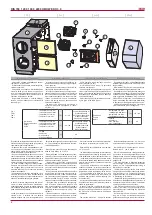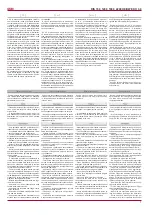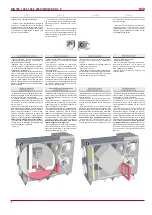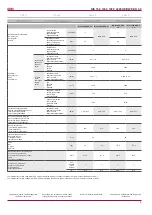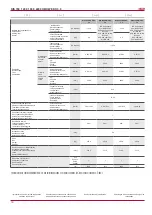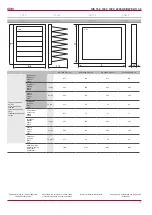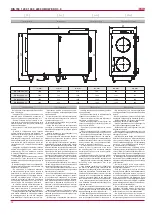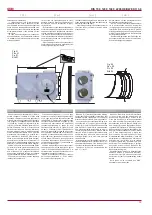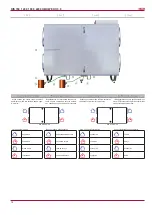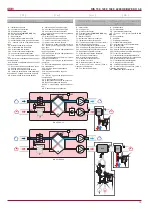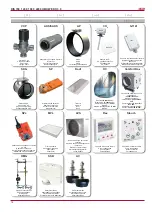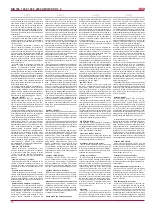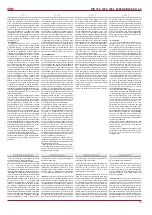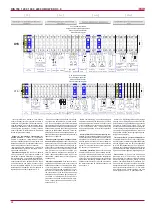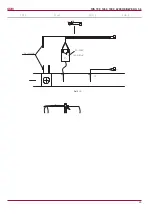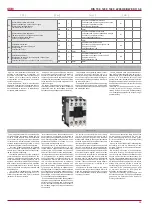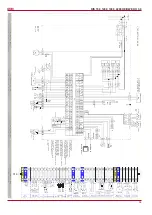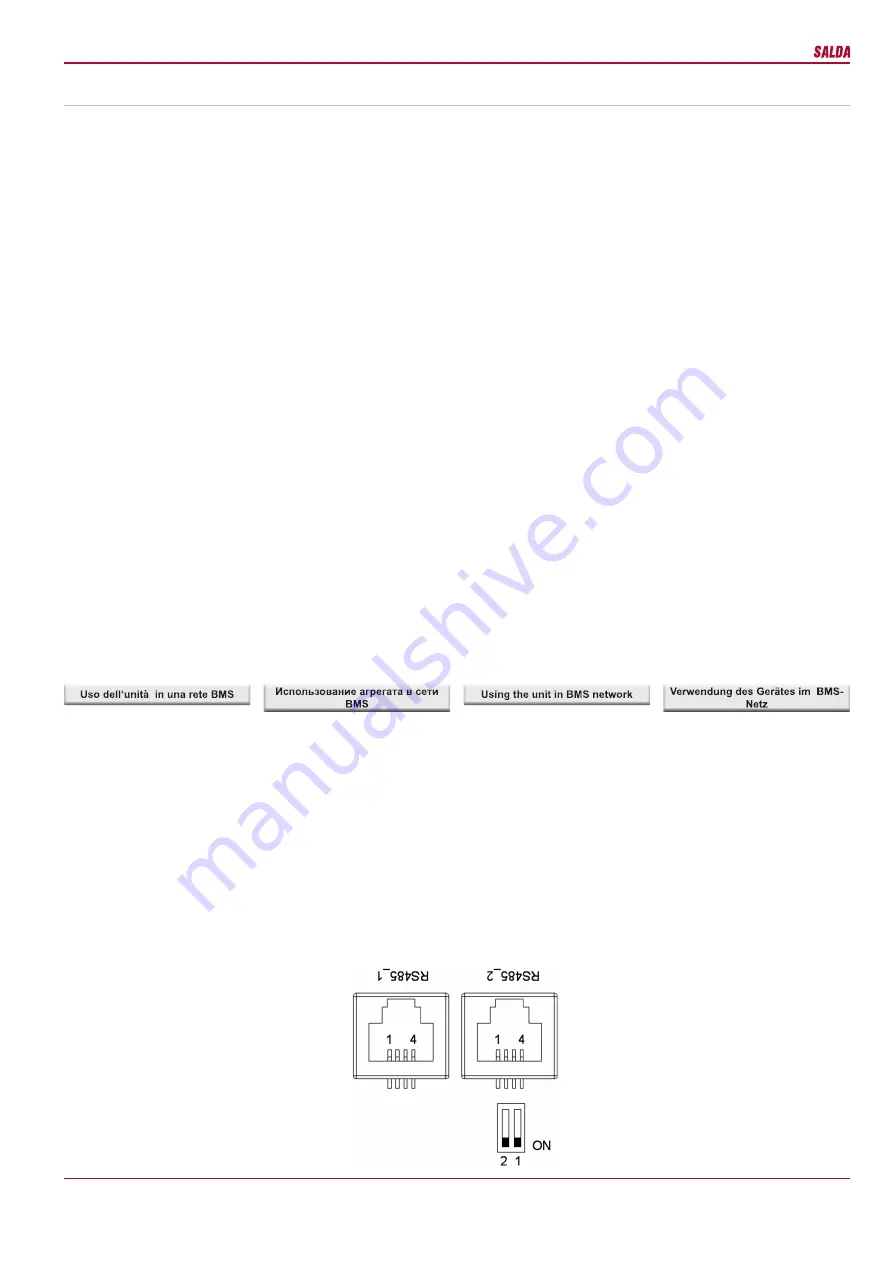
20
[ lt ]
[ ru ]
[ en ]
[ de ]
RIS 700_1200_1900_2200 HE/HW EKO 3.0
Il recuperatore può essere collegato alla rete
BMS attraverso il protocollo ModBus.
Il recuperatore può essere controllato tramite il
pannello di controllo Flex e tramite la rete BMS
contemporaneamente; il recuperatore funzio-
nerà in base alle ultime modifiche apportate
alle impostazioni. Il recuperatore è stato pro-
grammato in fabbrica in modo che dopo aver
disconnesso il pannello di controllo o la rete
BMS (oppure tutti e due) continui a funzionare
in base alle ultime impostazioni effettuate sul
pannello di controllo (se non ci sono messaggi
di allarme). Questa impostazione può essere
modificata: per maggiori informazioni vedere
il manuale di servizio del pannello di controllo
Flex.
Tipo di ModBus – RTU;
Per la connessione di ModBus si usaun’in-
terfaccia RS485_2 (fig. 3);
Impostazioni (vd. Descrizione di installa-
zione Flex II-6-2):
II-6-2):
Рекуператор может быть подключен к сети
BMS, использую протокол ModBus.
Управление может осуществляться одно-
временно и с пульта FLEX, и посредством
сети BMS, устройство будет работать в со-
ответствии с последними изменениями на-
строек. В соответствии с заводскими на-
стройками после отключения пульта или
сети BMS (или даже обоих) устройство про-
должит работать (если не поступят аварий-
ные сигналы) по последним установкам.
Это положение можно изменять, шире см.
Flex_meniu_montuotojas_LT 14 пункт «Misc»
Тип ModBus – RTU;
Для подключения ModBus используется
интерфейс RS485_2 (
Рис. 3
);
Настройки (см. Описание монтирования
FLEX II-6-2):
The recuperator can be connected to the BMS
network by using the ModBus protocol.
The device can be controlled using FLEX panel
and BMS network simultaneously: the device will
work based on the latest changes of settings.
As set in the factory, the device will operate (if
no faults are present) based on the latest panel
settings in case the panel or BMS network (or
even both) is disconnected. This setting can be
changed, please see Flex_meniu_montuotojas
section 14 “Misc” for details.
ModBus type: RTU
RS485_2 port is used for connecting the
ModBus (Fig. 3);
Settings (see section II.6.2. of the FLEX
installer description):
Der Rekuperator kann an einen BMS-Netz
mit einem ModBus-Protokoll angeschlossen
werden.
Zur gleichen Zeit kann sowohl durch den
FLEX-Pult als auch den BMS-Netz gesteuert
werden, die Anlage wird laut den letzten Ände-
rungen der Einstellungen arbeiten. Werkseitig
ist festgestellt, dass nach dem Abschalten des
Pults oder des BMS-Netzes (oder zugleich der
beiden) die Anlage auch weiter (wenn es keine
Pannenalarme gibt) laut den letzten Änderungen
der Einstellungen arbeiten wird. Diese Einstel-
lung kann geändert werden, mehr darüber:
Flex_meniu_montuotojas_LT, Punkt 14 „Misc“.
ModBus-Typ: RTU.
Fürs Anschließen des ModBusses wird
RS485_2-Anschluss gebraucht (Abb. 3).
Einstellungen (siehe Montagebeschreibung
von FLEX, II.6.2):
Pav. 3
Рис. 3
Fig. 3
Abb. 3
immissione. Nel caso di interruzione della man-
data questa serranda viene chiusa immediata-
mente. Questa serranda non si aprirà automa-
ticamente e dovrà essere ripristinata (restart)
tramite il pannello di controllo.
b)
Se il recuperatore di calore è dotato di bat-
teria elettrica sono previsti due livelli di prote-
zione contro il surriscaldamento. La protezione
termica automatica scatta quando la tempe-
ratura dell’aria si alza al di sopra dei +50 °С,
quella manuale invece scatta, quando la tem-
peratura dell’aria si alza al di sopra dei +100 °С.
La protezione termica auto50 °С serve
per disconnettere la batteria elettrica quando gli
elementi riscaldanti si riscaldano a temperatura
superiore a +50 °С e se non venissero disat-
tivati comincerebbero a consumare l’ossigeno
dell’aria immessa.
La protezione termica automatica è a riarmo
automatico, mentre quella manuale deve es-
sere riarmata premendo il tasto „RESET“ sulla
scocca della batteria elettrica.
Quando scatta la protezione termica manuale,
i ventilatori funzionano alla massima velocità
fino a che non sia stata ripristinata la prote-
zione manuale della batteria (premento il tasto
,,reset“) e sarà riavviato il dispositivo. Se è stato
registrato un guasto della batteria, indipenden-
temente dalla temperatura impostata sul pan-
nello di controllo, la protezione manuale può
essere rispristinata solo dopo aver individuato
la causa del guasto e dopo essersi assicurati
che il ripristino sia sicuro. In questo caso con-
trollare che aitri dispositivi e parti di impianto
non siano stati danneggiati.
Lo scatto della protezione termica automati-
ca solitamente avviene a causa di velocità del
ventilatore troppo bassa (ventilatore guasto,
serranda su presa d’aria con attuatore incep-
pato/ guasto).
пользуется (должен использоваться) привод
заслонки приточного воздуха с возвратной
пружиной. В случае пропадания тока, сразу
же закрывается заслонка приточного возду-
ха, она автоматически не восстанавливает-
ся, ее надо восстановить (restart) на пульте.
б)
Устройство с электрическим нагревате-
лем от перегрева защищено двумя уровня-
ми защиты. Электрический обогреватель от
перегрева защищен капиллярными термоза-
щитами двух типов – ручного и автоматиче-
ского. Автоматическая термозащита сраба-
тывает, когда температура воздуха превыша-
ет +50оС, а ручная срабатывает, когда тем-
пература воздуха превышает +100оС. Авто-
матическая термозащита +50оС использу-
ется для отключения электрического нагре-
вателя, когда нагревательные элементы на-
греваются свыше +50оС и начинают «сжи-
гать» кислород.
Капиллярные термозащиты по своей кон-
струкции различаются только тем, что пере-
гретая автоматическая термозащита сама
возвращается в рабочее положение, а руч-
ная термозащита не восстанавливается, она
должна быть возвращена в рабочее положе-
ние нажатием кнопки «Reset», расположен-
ной на крышке обслуживания обогревателя.
Когда срабатывает ручная термозащита,
вентиляторы начинают работать на полную
мощность и работают до тех пор, пока не бу-
дет восстановлена ручная защита нагревате-
ля (нажатием кнопки «Reset») и устройство не
будет включено повторно. Когда фиксирует-
ся поломка нагревателя, ручную защиту на-
гревателя, вне зависимости от установленной
на пульте температуры, можно восстановить
только после того, как потребитель опреде-
лит причину поломки и убедится в безопас-
ности этого поступка. Также следует убедить-
ся, что не повреждены другие элементы ав-
томатики и инсталляции.
Защита теплообменника от замерзания раз-
ностного давления (реле разностного давле-
ния PS 600) используется только в высокопро-
изводительных устройствах (от 1200 м3/h).
Срабатывание автоматической термозащи-
ты чаще всего происходит по причине низ-
кой скорости вентилятор (поломка вентиля-
тора, заедание/поломка заслонок/приводов
забора воздуха).
control panel.
b)
When the device has the electric heater, then
two levels of overheat protection are used. Two
types of the capillary thermal protections are
used for the overheat protection of the electrical
heater: manual and automatic. Automatic ther-
mal protection is activated when air temperature
e50 °C and manual protection is acti-
vated when air temperature e100 °C.
Automatic thermal prot50 °C is used to
disconnect the electric heater if the temperature
of the heating elements e50 °C which
could cause consumption of the oxygen.
Capillary thermal protections are different only
with respect to construction to allow automatic
thermal protection to reset to the operation state.
Manual thermal protection does not reset and
should be reset to the operation state by pressing
RESET button on the service cover of the heater.
When manual thermal protection is triggered,
fans operate in maximum capacity until the
manual heater protection is reset (by pressing
the reset button) and the device is restarted.
When heater fault is registered, manual heater
protection can be restored only after estimation
of the fault cause and only if it is safe to do so
regardless of the temperature setting on the
control panel. Also it should be inspected if
other automation and installation elements are
not damaged.
Antifreeze protection of the differential pres-
sure heat exchanger (differential pressure relay
PS600) is used only in more efficient devices
(from 1200 m3/h).
Triggering of the automatic thermal protection
mostly occur due to low fan speed (faulty fan,
stuck/faulty air inlet valve/actuator).
serheizers wird (muss) auch das Getriebe von
der Zuluftklappe mit einer Rückfeder gebraucht
(werden). Nach dem Spannungsausfall wird
sofort die Zuluftklappe geschlossen und sie wird
nicht von selbst wiederhergestellt und muss vom
Pult wiederhergestellt (neu gestartet) werden.
b)
Wenn die Anlage einen elektrischen Heizer
hat, hat sie zwei Schutzstufen gegen die Über-
hitze. Elektrischer Heizer ist gegen die Überhitze
mit zwei Arten des Kapillarthermoschutzes,
d.h. dem Handschutz und dem automatischen
Schutz, gesichert. Automatischer Thermoschutz
läuft an, wenn die Lufttemp50 °C über-
schreitet; Handthermoschutz läuft an, wenn die
Lufttemperatur +100 °C überschreitet. Auto-
matischer Thermoschutz von +50 °C wird fürs
Abschalten des elektrischen Heizers gebraucht,
wenn die Heizelemente über +50 ° erhitzen und
können beginnen, den Sauerstoff zu „brennen“.
Kapillarthermoschütze unterscheiden sich in
ihrer Aufstellung nur dadurch, dass der über-
hitzte automatische Thermoschutz selbst in
die Arbeitsstellung zurückkehrt. Im Falle des
Handthermoschutzes ist es nicht so, sie muss
in die Arbeitsstellung durch das Drücken der
RESET-Taste auf dem Bediendeckel des Heizers
zurückgebracht werden.
Wenn der Handthermoschutz anläuft, arbeiten
die Ventilatoren in voller Leistung bis dann, wenn
der Handschutz des Heizers wiederhergestellt
wird (durch das Drücken der RESET-Taste)
und die Anlage wieder eingeschaltet wird. Wenn
eine Störung des Heizers festgestellt wird,
kann der Handschutz des Heizers ungeachtet
der Temperatureinstellung auf dem Pult erst
dann wiederhergestellt werden, wenn man
die Störungsursache bewertet und man sich
vergewissert, dass diese Wiederherstellung
sicher ist. Es muss auch bewertet werden, ob
die anderen Automatik- und Anlagenelemente
nicht beschädigt sind.
Der Frostschutz des Unterschiedsdruck-Wär-
metauschers (durch Unterschiedsdruckrelais PS
600; es wird nur in leistungsfähigeren Anlagen
ab 1.200 m3/h gebraucht).
Das Anlaufen des automatischen Thermo-
schutzes ergibt sich meistens wegen der kleinen
Geschwindigkeit eines Ventilators (des beschä-
digten Ventilators, der blockierten/beschädigten
Einnahmeklappe/Getriebe der Luft).

